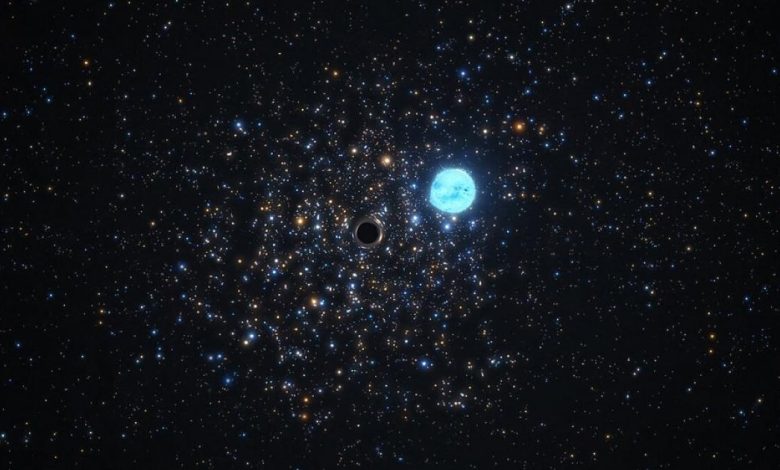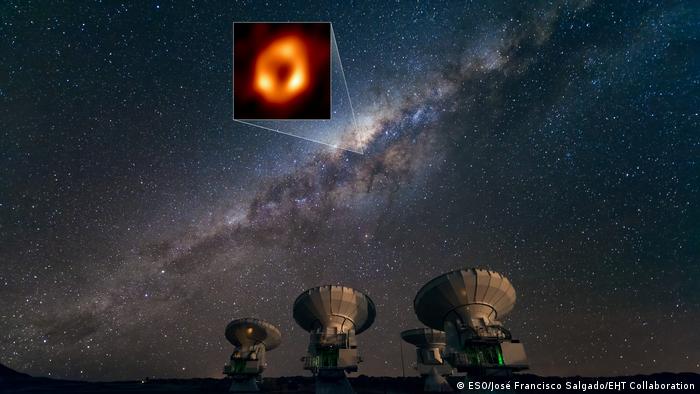The First Picture of the Black Hole at the Milky Way’s Heart Has Been Revealed
The historic image of Sagittarius A* is the culmination of a decades-long astronomical quest—and a crucial step toward a new understanding of black holes, gravity and spacetime

First image of Sagittarius A*, the supermassive black hole at the center of the Milky Way, as captured by the Event Horizon Telescope. Credit: EHT Collaboration
The mystery at the heart of the Milky Way has finally been solved. This morning, at simultaneous press conferences around the world, the astronomers of the Event Horizon Telescope (EHT) revealed the first image of Sagittarius A*, the supermassive black hole at the center of the Milky Way. It’s not the first picture of a black hole this collaboration has given us—that was the iconic image of M87*, which they revealed on April 10, 2019. But it’s the one they wanted most. Sagittarius A* is our own private supermassive black hole, the still point around which our galaxy revolves.
Scientists have long thought that a supermassive black hole hidden deep in the chaotic central region of our galaxy was the only possible explanation for the bizarre things that happen there—such as giant stars slingshotting around an invisible something in space at an appreciable fraction of the speed of light. Yet they’ve been hesitant to say that outright. For example, when astronomers Reinhard Genzel and Andrea Ghez shared a portion of the 2020 Nobel Prize in Physics for their work on Sagittarius A*, their citation specified that they were awarded for “the discovery of a supermassive compact object at the centre of our galaxy,” not the revelation of a “black hole.” The time for that sort of caution has expired.

At the National Press Club in Washington, D.C., this morning, Feryal Özel, a professor of astronomy and physics at the University of Arizona and a member of the EHT Science Council, introduced the picture, a dark ring framed by three shining knots of trillion-degree gas. “I met [Sagittarius A*] 20 years ago and have loved it and tried to understand it since,” Özel said. “But until now, we didn’t have the direct picture.”
Black holes trap everything that falls in, including light, so they are, in a very real sense, unseeable. But they warp spacetime around them so severely that, when they are illuminated by glowing streams of infalling matter shredded in their gravitational grip, they cast a “shadow.” The shadow is about two and a half times larger than a black hole’s event horizon: its boundary and its defining feature, the line in spacetime through which nothing that passes can ever return.
The EHT captures images of this shadow using a technique called very long baseline interferometry (VLBI), which combines radio observatories on multiple continents to form a virtual Earth-size telescope, an instrument with the highest resolution in all of astronomy. In April 2017 the EHT collaboration spent several nights pointing that virtual instrument at Sagittarius A* and other supermassive black holes. We’ve already seen the first finished product from that effort: M87*. The team also captured the raw data for the Sagittarius A* image in the same campaign, but converting those observations into an actual picture took much longer.
That’s because Sagittarius A* is constantly changing. M87*, the black hole at the heart of the galaxy Messier 87, or M87, is so huge that the matter swirling around it takes many hours to complete a full orbit. Practically speaking, that means you can stare at it for a long time, and it will scarcely change. Sagittarius A* is more than 1,000 times less massive, so it changes about 1,000 times faster, as matter moves in tighter, quicker orbits around the black hole. Katie Bouman, a California Institute of Technology computer scientist and astronomer who co-leads the EHT’s imaging working group, said that matter orbits Sagittarius A* so quickly that it changes “minute to minute.” Imagine taking a time-lapse photograph of a speeding bullet—doing so isn’t easy. That’s why extracting a clear image of Sagittarius A* from the data collected in the 2017 observing run has been the work of several years.
If Sagittarius A*’s mercurial nature made it hard to see, it also makes it an exciting laboratory for future studies of black holes and Einstein’s general theory of relativity, his hallowed theory of gravity. Through decades of study with all manner of telescopes, astronomers already knew Sagittarius A*’s basic measurements (its mass, diameter and distance from Earth) to great accuracy. Now, at last, they’ve gained the ability to watch it evolve—to watch as it feeds on flaring, flashing streams of matter—in real time.
Lifting a Many-Layered Veil
Scientists started to suspect that a black hole lurked in the heart of the Milky Way in the early 1960s, not long after the discovery of active galactic nuclei—extremely bright regions at the cores of some galaxies illuminated by voraciously feeding supermassive black holes. From our perspective here on Earth, active galactic nuclei are a thing of the past—we only see them in the distant universe. Where did they all go? In 1969 English astrophysicist Donald Lynden-Bell argued that they didn’t go anywhere. Instead, he said, they just went to sleep after their heavy meals—dormant supermassive black holes, he predicted, are slumbering all around us in the hearts of spiral galaxies, including our own.
In 1974 American astronomers Bruce Balick and Robert Brown pointed radio telescopes in Green Bank, W. Va., at the center of the Milky Way and discovered a dim speck they suspected was our galaxy’s central black hole. They found the speck in a slice of sky known as Sagittarius A. Radiation from the new source was lighting up—or “exciting”—surrounding clouds of hydrogen. Brown borrowed from the nomenclature of atomic physics, in which excited atoms are marked with an asterisk, and named the newfound speck Sagittarius A*.
For the next two decades, radio astronomers kept gradually improving their view of Sagittarius A*, but they were limited by a lack of suitable telescopes, relatively primitive technology (think reel-to-reel magnetic tape) and the inherent difficulty of looking into the galactic center.

Sagittarius A* is concealed by a multilayered veil. The first layer is the galactic plane—26,000 light-years’ worth of gas and dust that blocks visible light. Radio waves sail through the galactic plane unimpeded, but they’re obscured by the veil’s second layer—the scattering screen, a turbulent patch of space where density variations in the interstellar medium knock radio waves slightly off course. The final layer concealing Sagittarius A* is the obliterated matter surrounding the black hole itself. Peering through that barrier is a bit like peeling off an onion’s skins. The outer layers emit longer-wavelength light, so making VLBI work with shorter-wavelength light would enable closer-in views approaching the black hole’s event horizon. That, however, was a major technological challenge.
Astronomers using other techniques besides VLBI initially had more success, steadily gathering indirect evidence that Sagittarius A*’s “speck” was actually a seething supermassive black hole. In the 1980s physicist Charles Townes and his colleagues showed that gas clouds in the galactic center were moving in ways that only made sense if they were under the influence of some great, unseen gravitating mass. And in the 1990s Ghez and Genzel independently began tracking the orbits of giant blue stars in the galactic center, mapping their motion around a heavy but hidden pivot point.
Meanwhile the situation for radio astronomers improved. In the late 1990s and early 2000s a new generation of high-frequency radio telescopes started to come online—telescopes that, if augmented with lots of bespoke equipment, could participate in VLBI observations at the microwave frequencies thought to shine from the edge of Sagittarius A*’s shadow. At the same time, the computing revolution that led to solid-state hard drives and smartphones in every pocket vastly increased the amount of data that each observatory in a network of radio telescopes could record and process.
In 2007 a small precursor for the EHT took advantage of these trends and used a trio of telescopes in Hawaii, California and New Mexico to pierce the veil surrounding Sagittarius A*. They were far from making an image, but they saw something.
Scientists had known for a while that a black hole should, in certain circumstances, cast visible shadows. In 1973 physicist James Bardeen predicted that a black hole in front of a bright background would show its silhouette, although he decided that “there seems to be no hope of observing this effect.” And in 2000 astrophysicists Heino Falcke, Fulvio Melia and Eric Agol had shown that a microwave-gathering, Earth-size radio telescope should be able to see the shadow of Sagittarius A* against the glow of its surrounding ring of shattered matter.
Half a decade afterward, a few dozen of the astronomers and astrophysicists laboring in this obscure corner of astronomy agreed on the formal goal of building a virtual planet-scale radio telescope to observe that shadow. The first official kickoff meeting for the project occurred in January 2012, and the EHT was born.
Five years later, after growing into a collaboration of more than 200 scientists with eight participating observatories across the globe, the team took its first realistic shot at seeing the shadow of Sagittarius A*. Over the course of 10 days in April 2017, telescopes in North America, South America, Hawaii, Europe and Antarctica collectively zoomed in on the galactic center and other black holes, gathering 65 hours of data on 1,024 eight-terabyte hard drives, which were shipped to supercomputer banks in Massachusetts and Germany for correlation. Five years after that, the elated EHT researchers showed the world that their experiment worked. “We’ve been working on this for so long that, every once in a while, you have to pinch yourself,” Bouman said this morning. “This is the black hole at the center of our galaxy!”
Seth Fletcher is chief features editor at Scientific American. His book Einstein's Shadow (Ecco, 2018) is about the Event Horizon Telescope and the quest to take the first picture of a black hole. Follow Fletcher on Twitter @seth_fletcher
Recent Articles by Seth Fletcher
How Astronomers Finally Captured a Photo of our Own Galaxy's Black Hole
The Black Hole in the Middle of our Galaxy Looks like This
Truth, Lies & Uncertainty
https://www.scientificamerican.com/article/the-first-picture-of-the-black-hole-at-the-milky-ways-heart-has-been-revealed/

